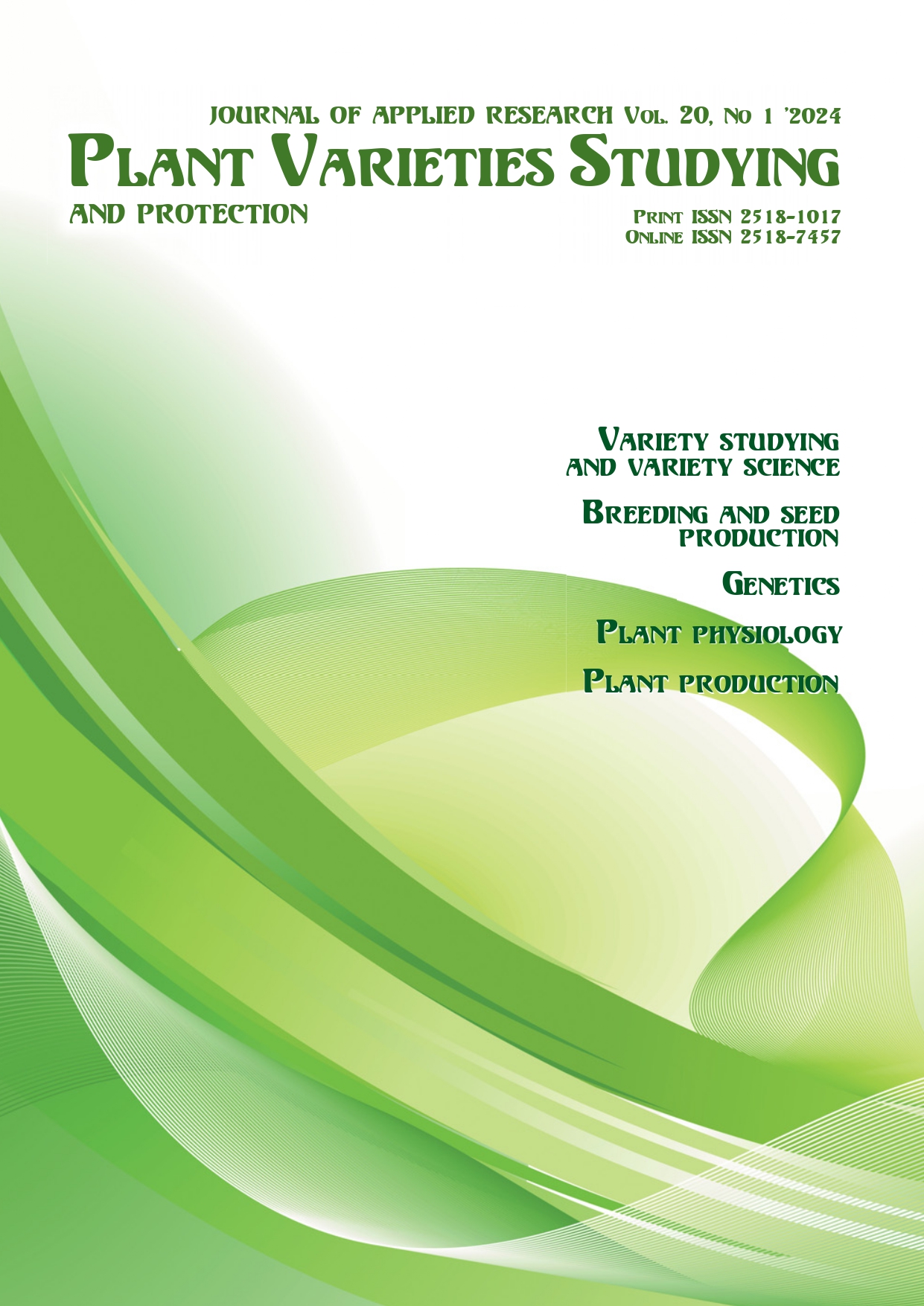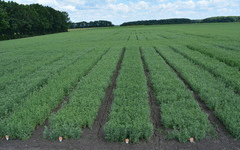Compatibility of Actinidia arguta with Schisandra chinensis and Malus domestica plants in mixed plantings
DOI:
https://doi.org/10.21498/2518-1017.20.1.2024.300135Keywords:
fruit vines, mixed plantings, photosynthetic pigments, biogenic element, amino acidAbstract
The accumulation of photosynthetic pigments, biogenic elements and amino acids in the leaves of A. argute (kiwi berry) and S. chinensis (Chinese magnolia vine) during their cultivation in the same vegetative containers was studied. Different ratios of the number of plants in the containers were used, namely 50%:50%, 33%:67%, and 67%:33%. Single-species plantings were used as a control. Research demonstrated that the ratios between co-planted plants can impact the levels of photosynthetic pigments, biogenic elements, and amino acids in their leaves. Mixed planting was found to decrease the concentration of photosynthetic pigments in A. argute leaves under these conditions. The chlorophyll a content showed significant changes, decreasing by 6.7–18.7% with S. chinensis ratio in the container and by 31.3–33.8% with M. domestica ratio compared to mono-planting. Chlorophyll b also showed differences, ranging from 1.2–8.6% and 9.7–29.7%, respectively. Additionally, certain features were observed in the distribution of mineral nutrition elements in plant tissues of A. arguta. In mono-planting conditions, the leaves of plants showed an increase in magnesium, potassium, and phosphorus content. When actinidia is grown together with Chinese magnolia vine and an apple tree, especially with an apple tree, the supply of nitrogen, phosphorus, potassium, and calcium to the plants is sharply reduced. By the end of the growing season of plants, the total content of free amino acids in A. arguta leaves increased in mono-planting conditions. Actinidia plants exhibited a disturbance in phosphate metabolism in mixed plantings, as evidenced by elevated levels of arginine and histidine, as well as altered nitrogen metabolism indicated by decreased concentrations of glutamic acid in the leaves. The competitiveness analysis, using the Vanderbeng and Ennik method, showed that A. arguta plants are more compatible with S. chinensis than with M. domestica. The productivity and sustainability of crops can be significantly increased by using the method of mixed crops in agrophytocenoses. However, it is necessary to consider the bioecological features of plants and their tolerance to root secretions of other species. A. arguta and S. chinensis are forest lianas that are a unique part of forest ecosystems. They grow in multispecies groups in natural conditions, so it can be expected that they will show tolerance in mixed plantings.
Downloads
References
Egorov, E. A. (2013). Ecological and economic efficiency of fruit growing intensification. Scientific works of GNU SKZNIISiV, 2, 7–21.
Kudasov, Y. L. (1999). On the issue of gardening ecology. Plant physiology – the basis of rational agriculture: Oryol phil. Island of plant physiologists RAM. 8-10.
Cesarano, G., Zotti, M., Antignani, V., Marra, R., Scala, F., & Bonanomi, G. (2017). Soil sickness and negative plant-soil feedback: a reappraisal of Hypotheses. Journal of Plant Pathology, 99(3), 545–570. doi: 10.4454/jpp.v99i3.3960
Wolińska, А., Kuźniara, А., Zielenkiewicz, U., Banach, A., & Błaszczykc, M., (2018). Indicators of arable soils fatigue–bacterial families and genera: a metagenomic approach. Ecological Indicators, 93, 490–500. doi: 10.1016/j.ecolind.2018.05.033
Mazzola, M., & Manici L. (2012). Apple replant disease: role of microbial ecology in cause and control. Annual Review of Phytopathology, 50, 45–65. doi: 10.1146/annurev-phyto-081211-173005

Chakchir, B. A., & Alekseyeva, G. M. (2002). Photometric methods of analysis: Guidelines. SPb; Izdvo SPKhFA.
Rinkis, G. Ya., & Nolendorf, V. F. (1982). Balanced plant nutrition micro and microelements. Riga. «Zinatna».
Volochay, V. I., & Kovalev, V. M. (2012). Study of the amino acid composition of the herb of Galinsogaparvi flora Cav and Galinsoga ciliate (Rafin) Blake. Zaporozhskiy meditsinskiy zhurnal, 3, 44–46.
Trimble, S. (2020). Chlorophyll Fluorescence Detects. Water Stress. October 21, at 9:35 pm Updated March 16, at 10:40 am https://cid-inc.com/
Taiz, L., & Zeiger, E. (2013). Fisiologia Vegetal. 5th Ed. PortoAlegre: Artmed.
Pérez-Bueno, M., Pineda, M., & Barónаyala, M. (2019). Phenotyping Plant Responses to Biotic Stress by Chlorophyll Fluorescence Imaging. Frontiersin Plant Science, 10, 1135. doi: 10.3389/fpls.2019.01135

Barros, J., Cavalcanti, J., Medeiros, D., Nunes-Nesi, A., Avin-Wittenberg, T., Fernie, A., & Araújo, W. (2017). Autophagy Deficiency Compromises Alternative Pathways of Respiration following Energy Deprivation in Arabidopsis the liana. Plant Physiol, 175, 62–76. doi: 10.1104/pp.16.01576

Wada, S., Ishida, H., Izumi, M., Yoshimoto, K., Ohsumi, Y., Mae, T., & Makino, A. (2008). Autophagyplays a rolein chloroplast degradation during senescen ceinin dividually darken edleaves. Plant Physiology, 149, 885–893. doi: 10.1104/pp.108.130013

Mukherjee, S., Chakraborty, A., Mondal, S., Sreshtha, S., Adil, N., & Sonali, P. (2019). Assessment of common plant parameters as biomarkers of air pollution. Environmental Monitoring and Assessment, 191(6), 1–8. doi: 10.1007/s10661-019-7540-y

Sayed, O. H. (2003). Chlorophyll Fluorescence as a Tool in Cereal Crop Research. Photosynthetica, 41, 321–330. URL: https://link.springer.com/article/10.1023/B:PHOT.0000015454.36367.e2
Baum, M., Grando, S., & Ceccarelli, S. (2006). Evaluation of Chlorophyll Content and Fluorescence Parameters as Indicators of Drought Tolerance in Barley. Agricultural Sciences in China. 751–757.
Guo, P. (2008). QTL sfor chlorophyll and chlorophyll fluorescence parameters in barley und erpost flowering drought. Euphytica, 163, 203–214.
Furukawa, A. (1991). Photosynthesis in leaves and environmental factors. Japanese journal of ecology, 41(3), 279–297. doi: 10.18960/seitai.41.3_279
Esteban R., Barrutia, O., Artetxe, U., Fernandez-Marın, B., Hernandez, A., & Garcıa-Plazaola, J. I. (2015). Internal and external factors affecting photosynthetic pigment composition in plants: A meta-analytical approach. New Phytologist, 206, 268–280.

Kuminov, E. P. (1999) Introduction of non-traditional plants into culture to obtain competitive products. Horticulture and viticulture, 1, 42–45.
Vandenberg, Ya. P., & Ennik, G. S. (1973). Relationships between plants. Physiological and biochemical bases of plant interaction in phytocenoses, 4, 47–57.
Published
How to Cite
Issue
Section
License
Copyright (c) 2024 T. B. Venediktova, N.V. Zaimenko, N.V. Skrypchenko

This work is licensed under a Creative Commons Attribution-ShareAlike 4.0 International License.
Starting in 2022, the copyright to the publication remains with the authors
Our journal abides by the CREATIVE COMMONS copyright rights and permissions for open access journals.
Authors, who are published in this journal, agree to the following conditions:
- The authors reserve the right to authorship of the work and pass the first publication right of this work to the journal under the terms of a Creative Commons Attribution License, which allows others to freely distribute the published research with the obligatory reference to the authors of the original work and the first publication of the work in this journal.
- The authors have the right to conclude separate supplement agreements that relate to non-exclusive work distribution in the form in which it has been published by the journal (for example, to upload the work to the online storage of the journal or publish it as part of a monograph), provided that the reference to the first publication of the work in this journal is included.

























 Ukrainian Institute for Plant Varieties Examination
Ukrainian Institute for Plant Varieties Examination  Селекційно-генетичний інститут
Селекційно-генетичний інститут Institute of Plant Physiology and Genetics of the National Academy of Sciences of Ukraine
Institute of Plant Physiology and Genetics of the National Academy of Sciences of Ukraine
 The National Academy of Agrarian Sciences of Ukraine
The National Academy of Agrarian Sciences of Ukraine